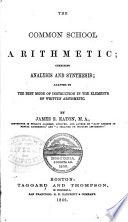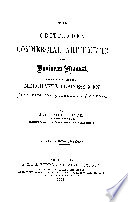 | Robert Johnston (F.R.G.S.) - 1863 - 254 pages
...RULE. — 1°. Multiply each debt by the time which should elapse before it will become due. 2°. Then divide the sum of the products by the sum of the debts. Various Departments. Ex. 1. Find by any rule with which you are acquainted the sum which, paid one... | |
 | James Stewart Eaton - Arithmetic - 1866 - 328 pages
...RULE 1. Multiply each debt by the number expressing the time to elapse before it becomes due, then divide the sum of the products by the sum of the debts, and the quotient is the .average term of credit. Add the average term of credit to the date of the... | |
 | Thomas Percy Hudson - Arithmetic - 1866 - 268 pages
...being reckoned : Multiply the amount of each debt by its corresponding time, and add the products. Divide the sum of the products by the sum of the debts. NB — When mercantile discount is reckoned (as is the case in practice), the rate per cent. does not... | |
 | John Groesbeck - Arithmetic - 1867 - 226 pages
...succeeding amount by the time intervening between the earliest date and the time the amount becomes due. Divide the sum of the products by the sum of the debts; the quotient will be the average time required. Add this average time to the day of maturity of the amount first falling due, for the... | |
 | John Groesbeck - Arithmetic - 1868 - 350 pages
...succeeding amount by the time intervening between the earliest date and the time the amount becomes due. Divide the sum of the products by the sum of the debts; the quotient will be the average time required. Add this average time to the day of maturity of the amount first falling due, for the... | |
 | Encyclopedias and dictionaries - 1868 - 856 pages
...generally given is as follows : Multiply each sum due by the time at which it is payable, and then divide the sum of the products by the sum of the debts : the quotient is the equated time. For example, if £10 be due at one month, and £20 at two months, find as an equivalent... | |
 | Encyclopedias and dictionaries - 1868 - 878 pages
...rule generally given is as follows: Multiply each sum due by the time at which it is payable, and then divide the sum of the products by the sum of the debts : the quotient is the equated time. For example, if £10 be due at one month, and £20 at two months, find as an equivalent... | |
 | John Fair Stoddard - Arithmetic - 1868 - 428 pages
...mo., and the equated time is July 4, 1865, or 6mo. from January 4. Rule. — Multiply each sum due by its term of credit, and divide the sum of the products by the sum of the payments, the quotient will be the average term of credit. NOTE. — This Rule, though sanctioned... | |
 | John Fair Stoddard - Arithmetic - 1888 - 480 pages
...mo., and the equated time is July 4, 1865, or 6rno. from January 4. Rule. — Multiply each sum due by its term of credit, and divide the sum of the products by the sum of the payments, the quotient will be the average term of creditF NOTE. — This Rule, though sanctioned... | |
 | Henry Bartlett Maglathlin - Arithmetic - 1869 - 332 pages
...of credit by the number denoting its debt, and divide the sum of the products by the number denoting the sum of the debts ; the quotient will be the average term of credit. The average term of credit, added to the date of the debts, will give the equated time. When any of... | |
| |